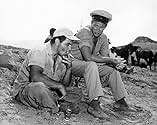IMDb RATING
6.3/10
1.2K
YOUR RATING
In 1944, US Navy specialists run a weather station in the Gobi desert where they are harassed by Japanese warplanes but aided by local Mongol nomads.In 1944, US Navy specialists run a weather station in the Gobi desert where they are harassed by Japanese warplanes but aided by local Mongol nomads.In 1944, US Navy specialists run a weather station in the Gobi desert where they are harassed by Japanese warplanes but aided by local Mongol nomads.
Max Showalter
- Walter Landers
- (as Casey Adams)
Edgar Barrier
- Yin Tang
- (uncredited)
Willis Bouchey
- Capt. Gates
- (uncredited)
James Conaty
- Admiral
- (uncredited)
Franklyn Farnum
- Quartermaster General
- (uncredited)
John Hedloe
- Pilot
- (uncredited)
Earl Holliman
- Frank Swenson
- (uncredited)
Frank Iwanaga
- Lieutenant
- (uncredited)
Storyline
Did you know
- TriviaNixon and Fallon, NV were both used as location sites, and Paiute Indians residing on a reservation in Nixon played Mongol extras.
- GoofsMcHale claims that "Gobi Desert" means "wall of spears." Actually, "Gobi" is the Mongolian word for "desert."
- Quotes
[Walter flirts successfully with a Mongolian woman]
Jenkins: Well, looks like you made a hit, Walter my boy. Tell me, how do you do it?
Walter Landers: My training as a meterorologist. I can take one look at a girl and tell weather.
- Crazy creditsOpening credits prologue: In the Navy records in Washington, there is an obscure entry reading "Saddles for Gobi."
This film is based on the story behind that entry--one of the strangest stories of World War II.
- ConnectionsEdited into All This and World War II (1976)
Featured review
This film has the feel of a documentary as sailor Richard Widmark frets at his role at a remote weather station in the Gobi Desert and yearns to get a ship under him again. Ultimately, he returns to the sea in an unexpected fashion.
The relationship between the sailors and the nomadic Mongols is a crucial part of the film. The nomads are credibly portrayed as human beings who are neither all good or all bad. The film gets high marks for its portrayal of the Mongol culture. It would have been so easy for the film to show people who looked like the Native American Indians Hollywood films are so comfortable with. The Mongol yurts have a realistic look and the film truly succeeds here in portraying a different and likeable culture.
There is little action in this film, but that's really not a problem. The unusual and probably unique story line more than makes up for it. The ending is a little hard to believe, but remember that anything is possible in films. Enjoy it.
The relationship between the sailors and the nomadic Mongols is a crucial part of the film. The nomads are credibly portrayed as human beings who are neither all good or all bad. The film gets high marks for its portrayal of the Mongol culture. It would have been so easy for the film to show people who looked like the Native American Indians Hollywood films are so comfortable with. The Mongol yurts have a realistic look and the film truly succeeds here in portraying a different and likeable culture.
There is little action in this film, but that's really not a problem. The unusual and probably unique story line more than makes up for it. The ending is a little hard to believe, but remember that anything is possible in films. Enjoy it.
- How long is Destination Gobi?Powered by Alexa
Details
Box office
- Budget
- $1,340,000 (estimated)
- Runtime1 hour 30 minutes
- Color
- Aspect ratio
- 1.37 : 1
Contribute to this page
Suggest an edit or add missing content




































